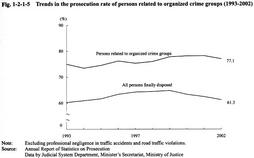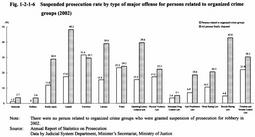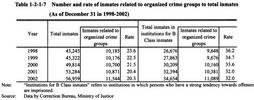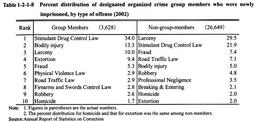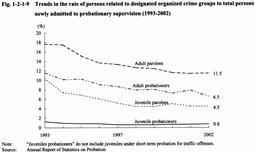| Previous Next Index Image Index Year Selection | |
|
|
3 Treatment of organized crime group members (1) Disposition by public prosecutors offices Fig. 1-2-1-5 shows the trends in the prosecution rates for total persons finally disposed and for persons related to organized crime groups (regular members or quasi-members of a group which might commit illegal violent acts habitually or as a group; hereinafter the same in 3 (1) of this Section), over the 10 years from 1993 to 2002. The prosecution rate for total persons was within the 60-65% range whereas that for persons related to organized crime groups was over 70%, marking 77.1% in 2002.
Fig. 1-2-1-5 Trends in the prosecution rate of persons related to organized crime groups (1993-2002) Fig. 1-2-1-6 compares the suspended prosecution rates, by type of major offense, for total persons finally disposed and for persons related to organized crime groups in 2002. In those offenses such as bodily injury, assault, larceny, gambling/lottery violation acts, and Bicycle Racing Law violations, the suspended prosecution rate for persons related to organized crime groups was far below that for total persons finally disposed.Fig. 1-2-1-6 Suspended prosecution rate by type of major offense for persons related to organized crime groups (2002) (2) Correctional treatment of designated organized crime group members (a) Imprisonment of convicts related to organized crime groups Table 1-2-1-7 shows the trends in the number and the rate of inmates related to organized crime groups to total inmates at the end of each year over the last 5 years. The rate of inmates related to organized crime groups to total inmates was 20.3% as of December 31, 2002. However, in the institutions for B Class inmates with a strong tendency towards offenses, the rate of organized crime groups was 32.0%.
Table 1-2-1-7 Number and rate of inmates related to organized crime groups to total inmates (As of December 31 in 1998-2002) (b) Characteristics of designated organized crime group members who were newly imprisoned (i) Status in the organized crime groups Among the inmates newly imprisoned in 2002, 3,628 (12.0%) were designated organized crime group members (members of designated organized crime groups, etc. under the Anti-Organized Crime Group Law; hereinafter the same in 3(2) of this section), 1,217 were leaders, 1,969 were ordinary members, and 442 were of unknown status (Source: Annual Report of Statistics on Correction).
(ii) Type of offense Table 1-2-1-8 shows the 10 most common offenses committed by designated organized crime group members or committed by other inmates who were newly imprisoned in 2002.
Table 1-2-1-8 Percent distribution of designated organized crime group members who were newly imprisoned, by type of offense (2002) (iii) Term of imprisonment When we examine the term of imprisonment of designated organized crime group members who were sentenced to imprisonment with or without labor and newly imprisoned in 2002, most of them were sentenced to over 1 year but not more than 2 years (36.7%), followed by those sentenced to over 2 years but not more than 3 years (24.3%), over 6 months but not more than 1 year (14.4%), over 3 years but not more than 5 years (14.3%), over 5 years (7.1%, including those sentenced to imprisonment for life), and not more than 6 months (3.4%) (Source: Annual Report of Statistics on Correction).
(iv) Age As for the age of designated organized crime group members who were newly imprisoned in 2002, most of them were aged 30-39 (37.6%), followed by those aged 20-29 (22.2%), those who aged 40-49 (19.2%), those aged 50-59 (17.5%), those aged 60 or over (3.5%), and those under 20 years of age (0.1%) (Source: Annual Report of Statistics on Correction).
(v) History of imprisonment As for the history of imprisonment of designated organized crime group members who were newly imprisoned in 2002, the highest was "1 time" with 31.0%, followed by "2 times" with 19.1 %, "6-9 times" with 14.8%, "3 times" with 13.3%, "4 times" with 10.1%, "5 times" with 7.7%, and "10 times or more" with 3.9% (Source: Annual Report of Statistics on Correction).
(c) Treatment in correctional institutions Correctional institutions provide guidance for organized crime group members to regulate their daily life and acquire the habit of working, and positively encourage them to leave organized crime groups with the support of the police and other authorities concerned. While allotting works and rooms to them with special care, correctional institutions take necessary measures to maintain strict discipline and order in the institutions by housing them separately in the same institution or transferring them to other institutions.
(3) Rehabilitation services for persons related to designated organized crime groups Fig. 1-2-1-9 shows the trends over the last 10 years in the rate of probationers/parolees related to designated organized crime groups (referring to persons who are considered to have a connection with designated organized crime groups provided in the Anti-Organized Crime Group Law by the time of admission to probationary supervision) to all probationers/parolees newly received, by probation/parole type.
Fig. 1-2-1-9 Trends in the rate of persons related to designated organized crime groups to total persons newly admitted to probationary supervision (1993-2002) The categorized treatment system (see Part 2, Chapter 5, Section 3-3 ) regards the following probationers/parolees as "persons related to organized crime groups": (a) those who are leaders, members, and quasi-members of organized crime groups; or (b) those who previously fell under (a) above and are not considered to leave the groups completely. For those probationers/parolees who fall under this: category, in cooperation with the police and prefectural centers for promoting the violence-expulsion movement, the endeavor is made to understand their daily lives correctly and provide them with positive guidance and assistance in order to encourage them to leave the groups and establish a stable life with decent jobs.Explanation of terms Designated organized crime groups/designated organized crime groups, etc:> The Anti-Organized Crime Group Law regulates designated organized crime groups and alliances of designated organized crime groups, which are collectively called designated organized crime groups, etc. However, all of the 24 organized crime groups that have received designation by December 31, 2002, are designated organized crime groups. The Prefectural Public Safety Commission decides such designation through specific procedures such as holding public hearings or requesting the consent of the National Public Safety Commission. Stop order: The Anti-Organized Crime Group Law prohibits some acts which have not been regulated under the traditional laws and regulations, such as a violent act of designated organized crime group members demanding money or goods from citizens by flaunting the threat of the designated organized crime groups to which they belong. Against those designated organized crime group members who have committed such illegal acts, the Prefectural Public Safety Commission may issue orders to stop such acts or to take necessary actions to stop them. These orders are called "stop orders," and a person who violates such order shall be sentenced to imprisonment with labor or to fine. Additionally, the partial amendment of the Law in 1997 provides that a person who has a certain relationship with a designated organized crime group but is not a designated organized crime group member shall also be subject to a stop orders, as having committed a quasi-violent act, when he demands money or goods from citizens by flaunting the threat of the designated organized crime groups to which he is related. Recurrence preventive order: In cases where designated organized crime group members have committed the acts that are prohibited by the Anti-Organized Crime Group Law and where there is a possibility that they will repeatedly commit similar acts, the Prefectural Public Safety Commission may issue orders, which are effective for a certain period within 1 year, for necessary actions to prevent such acts. These orders are known as "recurrence preventive orders," and a person who violates such order shall also be sentenced to imprisonment with labor or to fine. Moreover, under the partial amendment of the Law in 1997, quasi-violent acts shall also be subject to recurrence preventive orders. |
